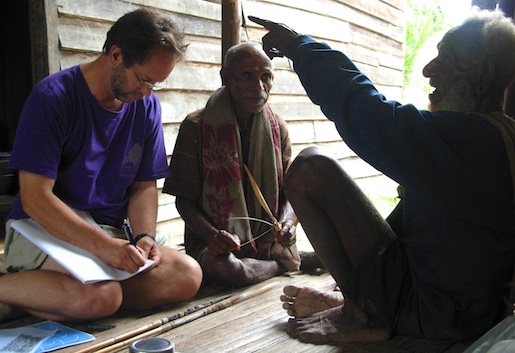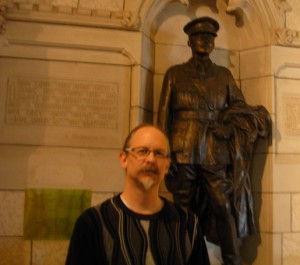By guest contributor Roger Ivar Lohmann, Associate Professor of Anthropology, Trent University
 Roger Lohmann in 2007 discussing Asabano arrows, formerly used in warfare, with elders Kafko and Bledalo during his ethnographic research in Papua New Guinea. (Photo by D. R. Garrett)
Roger Lohmann in 2007 discussing Asabano arrows, formerly used in warfare, with elders Kafko and Bledalo during his ethnographic research in Papua New Guinea. (Photo by D. R. Garrett)Imagine yourself living in a tiny village in central New Guinea to study the customs of its people. Although you’re a foreigner, the locals are kind and share with you. In stark contrast to your own society, they committed to abolishing warfare long ago and have had no wars for half a century. Rather than using organized homicide to achieve political ends, they pray to cool hawkish tempers. They settle disputes and cement goodwill through meetings and gift exchanges. This is the world I lived in as an anthropologist doing ethnographic research among the Asabano people.
Cultures change. As a scholar of how this happens, I loved whiling away hot afternoons in the shade of elders’ leaf-thatched houses, sharing stories. They told me about Asabano culture before trade goods, the colonial government, and mission Christianity arrived from the outside world. Among their accounts were harrowing tales of wars in which they had fought and suffered. They told of whole families slaughtered in surprise dawn attacks, of villages burned, and of children and young women captured to live out their lives among those who had massacred their people. They also told of times when peace-making exchanges and commensality replaced wartime theft and killing. However, when peace was declared between two peoples, it implied a potential war alliance against others. Peaceful relations could be fragile and subject to reverses.
Elders said they were able to end warfare for good as a result of their conversion to Christianity. They maintain peace through a god’s intervention as a powerful mediator with a monopoly on revenge. In situations that formerly would have incited them to join in war, they now pray for those who have offended them, and for God to undertake just retribution. This simple recipe frees them from impulses to organize revenge raids and alliances of war by giving them a means of satisfaction that neither offends opponents nor precipitates new violence.
The fact that the mediator whom the Asabano credit with keeping their peace is a supernatural being—with no scientifically demonstrable reality other than as an idea in their own minds—just shows the power that culture has to generate real-world effects. People make up the cultural belief systems and ideologies they live by. Those that motivate us to make either war or peace can be based on religion, but need not be. By making war taboo, and instituting rituals designed to undermine the urge to make war that are based in universal science and humanism rather than particular supernatural beliefs, disputes between culturally different polities can be resolved without resorting to mass killing and organized vandalism. We have the power to direct resources away from procuring more killing capabilities and toward designing and communicating better peace-maintaining ideologies and rituals.
It takes no belief in a jealous god, for example, for anyone to recognize that when we use killing to convince, even in the name of peace, by definition we are actually perpetuating war. The last hundred years was the bloodiest in the history of war. Since World War I—supposed to be the war to end all wars—began in 1914, globally we have killed over 187 million of our fellow human beings in wars. We should know better than to sanction and use state-sponsored violence as a means of political persuasion. Yet, when taunted by those who use violence against us, even the most powerful states all too readily sink to the level of their bullying antagonists, convincing themselves that answering one atrocity with an even bigger one is a noble, patriotic deed.
 Roger Lohmann in 2014 at the memorial of World War I casualty George Harold Baker in the Parliament of Canada during a Green Party of Canada tour. (Photo by Jaymini Bhikha)
Roger Lohmann in 2014 at the memorial of World War I casualty George Harold Baker in the Parliament of Canada during a Green Party of Canada tour. (Photo by Jaymini Bhikha)My late father served in the Second World War. Though his radio-monitoring duties spared him from having to fight, he was deeply moved by the destructiveness of war. For my part, as a young man I was sickened at the possibility that my government could call on me to kill people of another country. When I was a graduate student, my father challenged me to use my expertise in the cause of getting rid of our addiction to war: “You anthropologists should be able to find out how we can stop war for good.” I agreed, but the culture surrounding me kept reaffirming that ending war is a pipe dream. Yet there were others who thought the effort worthwhile. Green Parties around the world, sharing nonviolence as a key value, have continued advocating transition to a sustainable and peaceful society despite stubborn cultural inertia. These influences inspired me to assume, until proven otherwise, that sustainable peace is possible, and to discover what could be learned from the Asabano experience of ending war to help the rest of us do the same.
Refusing to take nonviolence seriously as a real possibility and a viable option for government policies is holding us back. Taking war for granted as a necessary part of life is a self-fulfilling prophesy—an illusion that leads us to keep killing, just as Asabano prayer can be seen as an illusion that stops them from killing. There have to be better ways to resolve our conflicts than killing each other, and there are. Taking a sympathetic and sustained look into the world’s cultures to see other possible ways of doing things—one of anthropology’s specialties—is one of the best ways we have to shake off our own culture’s blinders and complacency that literally keep us killing and being killed.
The notion that war is inevitable in today’s world (a violent ideology) and the resulting practice of continuing to rely on war to achieve political ends (a violent ritual) are cultural notions that stand in the way of our establishing lasting peace. Like other cultural beliefs that are not backed up by science, they have real-world consequences in the vast resources in lives, effort, money, and materials that we direct away from, and actually use to undermine, a society that is actively at peace with our fellow human beings in other societies. “Peace on Earth” can and should be a serious goal rather than a vacuous platitude uttered on holidays.
Read Roger Ivar Lohmann’s articles, “Investigating the Causes of Peace to End War: An Introduction” (French version also available), “A Cultural Mechanism to Sustain Peace: How the Asabano Made and Ended War” and the other articles in his guest-edited thematic section “Ending War and Sustaining Peace in Pacific Societies” in the most recent issue of Anthropologica.
Comments on this entry are closed.